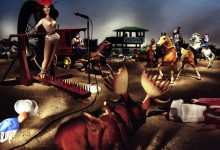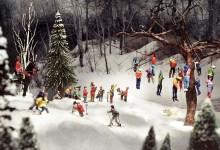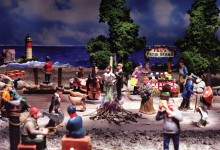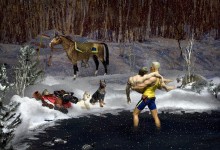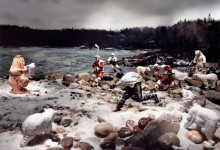Diana Thorneycroft: The Canadiana Martyrdom Series
Several years ago a friend gave me a book called Torment in Art which chronicles paintings of Christian martyrs undergoing barbaric executions. Using the paintings as templates, I made a series of photographic replicas of the same saints suffering their martyrdom and called the body of work Martyrs’ Murder. In my photographs, however, dolls and not humans were being “tortured”, and subsequently the reading of the work shifted from spiritual enlightenment towards the absurd. And despite the attention to detail, the overall results were more comical than realistic; the clothing was crudely made and often ill-fitting, the gestures of the dolls stiff and awkward and the landscapes artificial. These scenes were obviously staged, as was the infliction of pain they depicted. The preposterousness of plastic figurines maiming each other introduced a slightly black kind of humour and the semblance of child’s play.
The last image I did for that series was entitled The Martyrdom of St. Nicholas. In this photograph I no longer used an existing painting as a template. The image depicted Santa Claus on a cross in an idyllic Canadian winter landscape. In the foreground there was a cross country skier who appeared to have “stumbled” upon the scene. Half hidden in the snow were two rabbits in their white winter fur, and stuck into the snow in-between a fir tree and the cross was a pair of snow shoes. As there is no historical narrative that goes along with this image, the reading of it is much less fixed and I hoped, a bit more humourous.
The ideas contained within The Martyrdom of St. Nicholas lead me to a new body of work, called The Canadiana Martyrdom Series. My strategy for these photographs is to use paraphernalia that is quintessentially Canadian: landscapes obtained from calendars and tourism posters (eg. panoramic vistas of the Rockies or the wheat fields of Saskatchewan),Canadian “icons” like Anne of Green Gables, the RCMP, hockey players and Bob and Doug MacKenzie, and animals associated with the north, such as polar bears, elk, moose, beavers and howling wolves. The photographs still depict spectacles of violence; martyrs continue to die, and the audience, both animal and human, still bear witness to the crimes being committed, but the narratives, now absurdly “Canadiana”, are more ambiguous and layered than previous work. The content no longer refers to specific Christian martyrs but to tourism, national identity, Canadian culture and industry. The work also addresses issues about apathy (how life goes on despite the violence around us), and the way in which murder is used as a form of entertainment (note the popularity of the TV show CSI). I’m also curious how humour functions when it comes to images of human suffering, and whether it is possible to suspend disbelief when viewing the torture of plastic dolls.


